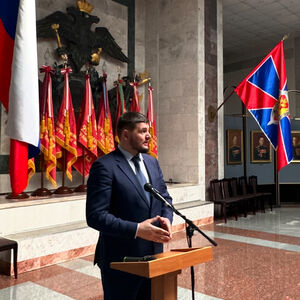41466 (686873), страница 5
Текст из файла (страница 5)
2. Socio-cultural contest for creating the most efficient socio-cultural standard for Chinese SCS (from 770 to 221 BC - Eastern Chou Dynasty)
3. Unification of the Chinese SCS territory based on the chosen socio-cultural standard. Beginning of the homeland growth and establishing the naturally dependent vassals (221 BC - 317 AD)
4. Creating the internal buffer zone on the North, new naturally dependent vassals on the West and new homeland on the South (317 - 1211 AD)
5. Socio-cultural integration with Barbarian-Nomadic SCS. Creating the internal buffer zones, naturally dependent vassals and homeland growth on the South. Unification of the socio-culturally transformed territories into the united state (from 1211 until 1840-s)
6. Defining the buffer zones’ territories through conflict with various SCS-s. Military, political and economic presence of alien socio-cultural systems in the Chinese homeland. Beginning of the Chinese population intensive diffusion around the World (from 1840-s until the Great Cultural Revolution)
7. Creating the integral internal buffer zone and liberation of the Chinese homeland from the alien socio-cultural systems’ presence. Establishing the Chinese enclave-communities within Western SCS and the mixed socio-cultural regions (as from the end of the Great Cultural Revolution and for some future)
WESTERN SCS
(Models 22 - 28)
1. Initial period of the Western population existence and Western SCS creation. Initial sporadic colonozation of the homeland territory in the most ancient civilizations (from ancient times until 770 - 750-s BC)
2. Greek-Roman times. Western homeland growth. Rise of the first Empires and Greek-Roman communities outside the homeland. Establishing the buffer zone with Barbarian-Nomadic SCS (770 - 750-s BC - 380-s AD)
3. Socio-cultural integration with Barbarian-Nomadic SCS. Transformation and further expansion of the homeland. Creating internal buffer zones. Defining the new ideological grounds of Western SCS, based on Roman Catholicism (from 380-s AD until the Crusades beginning)
4. Socio-cultural contest of Western SCS. Transformation of the Pyrenees Muslim enclave into internal buffer zone. Creating naturally dependent vassals in the East-European buffer zone. Expansion outside own homeland into the mixed socio-cultural regions (from the Crusades beginning until the discovery of America)
5. Global overseas colonial expansion of Western national states. Growth of the homeland in the mixed socio-cultural regions with Western predominance (1490-s - 1918)
6. Global war against other socio-cultural systems headed by Russian SCS. Losing the control over colonies. Reversion of Western population into own homeland and its redistribution between the mixed socio-cultural regions with Western predominance and traditional Western territories (1918 - 1990-s)
7. Transformation of the European homeland and stimulating further population redistribution between the territories of old homeland and mixed socio-cultural regions with Western predominance. Creating the American and South-Eastern internal and external buffer zones (from 1990-s and for some future)
RUSSIAN SCS
(Models 29 - 35)
-
Initial period of the Slavonic world existence, with undeveloped socio-cultural differences (from ancient times until 882 AD)
-
Period of the socio-cultural differences defining in the Slavonic world. Early accumulation of the Russian SCS territory and population as well as establishing the internal and external buffer zones (from 882 until middle - end of the XI century)
-
Socio-cultural contest for creating the most efficient socio-cultural standard for Russian SCS. Socio-cultural integration with barbarian-nomadic SCS (from the end of the XI century until 1572)
-
Creating the united Russian state, with utmost homeland, based on Moscow socio-cultural standard (from 1572 until 1700)
-
Imperial program of the Russian SCS: creating naturally dependent vassals and further homeland growth; expansion into neighbouring SCS-s as resistance to Western SCS pressure onto these SCS-s (from 1700 until 1917)
-
Communist program of the Russian SCS: defining boundaries of own socio-cultural spaces (especially internal and external buffer zones); leading the global war against Western SCS expansion outside its homeland (1917 - 1991)
-
Nationalist program of the Russian SCS: re-structuring own socio-cultural spaces; maintaining balance of socio-cultural powers in the World (from the end of the XX century and for some future)
HINDU SCS
(Models 36 - 42)
1. Initial period of the Indian population existence and rise of the ancient Hindu civilizations as a form of sporadic colonization of the territory. Rise of the Hindu SCS religious, cultural and social foundations (2500-s - 327 BC)
2. First contacts with Muslim SCS. Beginning of the homeland growth and establishing the North-Western buffer zone (327 BC - 711 AD)
3. Muslim SCS attacks withstanded. Creating the buffer zone on the joints with Muslim SCS (711 - early XIII century)
4. Muslim SCS intervention and establishing the vassal military-political control over the Northern and Central regions of the Hindu homeland. Further evolution of the Hindu homeland (early XIII century - 1658)
5. Military-political control of the Great Britain and co-operation with it to withstand the Muslim SCS expansion. Adaptation of Western innovations and Hindu population diffusion into other socio-cultural formations as a vassals of British colonists. Creating the internal buffer zones; conflict with Muslim and Chinese SCS-s for the external buffer zones (1658 - 1945)
6. Transition to an indirect forms of co-operation with Western SCS in the struggle against Muslim and Chinese SCS-s. Extreme point of the conflict with Muslim SCS for control over buffer zones. Further developing the internal buffer zones; efforts to transform the external buffer zones into naturally dependent vassals (from 1945 and for some future)
7. Prognostic stage: Retention of the indirect forms of co-operation with Western SCS to withstand the Muslim and Chinese SCS-s expansion. Final stages of creating the internal and external buffer zones. Political-geographical transformation of the Hindu homeland based on its own socio-cultural standards (more distant future)
SOUTH-AMERICAN SCS
(Models 43 - 49)
1. Initial existence of the South-American population and sporadic colonization of the territory in form of the most ancient civilizations (from ancient times until the end of the XV century)
2. Socio-cultural integration with Western and Black African SCS-s. Spatial colonization / assimilation of the territory and creating the renewed basis for South-American SCS (from 1490-s until the 1823 Monroe Doctrine)
3. Establishing the internal buffer zones and re-structuring own territory based on the national states principles. Permanent military-political and economic presence of Western SCS (represented by the USA) (1823 - 1918)
4. Operative involvement of the USA into South-American SCS rising. Introduction of economic, social and military innovations. Further creating the internal buffer zones. Co-operation of South-American and Russian SCS-s in the struggle against permanent presence of the USA (1918 - 1980-s)
5. Liberation of the South-American SCS homeland from military, economic and political presence of all the alien socio-cultural systems. Creating the buffer zone with Western SCS (in the mixed socio-cultural region with Western predominance in North America). Operative conversion of the submitted Western economic and social innovations (from 1980-s and for some future)
6. Prognostic stage: Socio-cultural contest in South-American SCS and its re-structuring in accordance with the own renewed socio-cultural standards (this period may last for a 100 years or more)
7. Prognostic stage: Further intensive development of the South-American SCS territory based on its own socio-cultural standards (quite distant future)
BLACK AFRICAN SCS
(Models 50 - 56)
1. Initial period of the Black African population existence on the territory of its homeland, at the stage of clan-tribal organisation (from ancient times until IV century AD)
2. Beginning of the contacts with Muslim SCS, rise of the early States; creating the Northern and Eastern internal buffer zones (IV century - 1490-s)
3. Beginning of the contacts with Western SCS, creating the Western and Southern internal buffer zones. Overseas diffusion of the Black African population and establishing the enclave-communities within alien socio-cultural formations. Participation in the evolution of South-American SCS, on its 2nd stage (1490-s - 1880-s)
4. Spatial seizure of Black African SCS by Western SCS. Introduction of the superficial economic, social and military innovations. Co-operation of Black African and Russian SCS-s in the struggle against Western SCS control over the Black African homeland (1880-s - 1960)
5. Liberation of the Black African SCS homeland from military, economic and political presence of all the alien socio-cultural systems. Operative conversion of the submitted economic and social innovations (from 1960 and for some future)
6. Prognostic stage: Socio-cultural contest in Black African SCS and its re-structuring in accordance with the own renewed socio-cultural standards (this period may last for a 100 years or more)
7. Prognostic stage: Further intensive development of Black African SCS based on its own socio-cultural standards. Establishing connections between the Black African homeland and its overseas enclave-communities (quite distant future)
4. EVOLUTION OF THE SPACES OF THE SOCIO-CULTURAL SYSTEMS: NUMERICAL SYMBOLS TO THE TIME-SPATIAL MODELS
Barbarian-Nomadic SCS
Model 4.
-
Vikings - Varangians as a part of Barbarian-Nomadic SCS
-
Western Slavs (Poles)
-
Magyars (Hungarians) as a part of Barbarian-Nomadic SCS
-
Southern Slavs
Model 5.
-
East-European buffer zone
-
South-European buffer zone
-
Japanese SCD
Model 6.
-
North-European buffer zone
-
East-European buffer zone
-
South-European buffer zone
-
Minor-Asian buffer zone
-
Crimean Khanate and its assimilation into Russian SCS
-
Territories inhabited by Kazakhs, Kalmuks etc. and their socio-cultural transformation
-
Territories inhabited by Mongols etc. and their socio-cultural transformation
Muslim SCS
Model 9.
-
Areas within European continent controlled by Muslim SCS of its 2nd stage
Model 10.
-
Areas within European continent controlled by Muslim SCS of its 3rd stage
-
Assimilation of Barbarian-Nomadic SCS migrants (vandals) during V - VI centuries
-
Assimilation of Alexander the Great and his armies during IV century BC
Model 11.
-
Areas within European continent controlled by Muslim SCS of its 4th stage
-
East-European buffer zone
-
South-European buffer zone
-
Byzantine Empire as a buffer zone
Model 12.
-
Western enclave within Muslim SCS
-
East-European buffer zone
-
South-European buffer zone
-
Byzantine, and then Ottoman Empire as a buffer zone
-
Military-political vassals within the territories of Barbarian-Nomadic SCS (in Middle Asia)
-
Military-political vassals within the territories of Hindu SCS
-
Military-political vassals within the territories of Black African SCS
Model 13.
-
Western enclave within Muslim SCS
-
East-European buffer zone
-
South-European buffer zone
-
Ottoman Empire as a buffer zone
-
Buffer zone between Hindu and Muslim SCS-s
-
Enclave-communities within the territories of mixed socio-cultural regions
Model 14.
-
East-European buffer zone
-
South-European buffer zone
-
Turkey as a buffer zone
-
Buffer zone between Hindu and Muslim SCS-s
-
Enclave-communities within the territories of mixed socio-cultural regions
-
Enclave-communities within the territories of Black African SCS
Chinese SCS
Model 18.
-
Japanese SCD
Model 19.
Other socio-cultural formations
-
Japanese SCD
Buffer zone
-
Taiwan
-
Manchuria
-
Mongolia
-
Western territories
-
Tibet
Model 20.
Other socio-cultural formations
-
Japanese SCD
External buffer zone
-
Mongolia
Internal buffer zone
-
Manchuria
-
Western territories
-
Tibet
Western enclaves within the Chinese homeland
-
Taiwan
-
Hong Kong and Macao
Enclave-communities
-
Enclave-communities within the territory of Western SCS
Model 21.
Other socio-cultural formations
-
Japanese SCD
External buffer zone
-
Mongolia
Internal buffer zone
-
Manchuria
-
Western territories
-
Tibet
Chinese homeland
-
Taiwan
Enclave-communities
-
Enclave-communities within the territory of Western SCS
-
Enclave-communities within the territory of mixed socio-cultural regions
Western SCS
Model 23.
-
Greek-Roman enclaves within Barbarian-Nomadic SCS
-
Greek-Roman enclaves within Asia Minor as an external buffer zone
-
Greek-Roman enclaves within Muslim SCS (in Northern Africa)
-
Western conquerors assimilated in Muslim SCS
Model 24.
-
German states as the Eastern internal buffer zone
-
Italy and Greece as the Southern internal buffer zone
Model 25.
-
German states as the Eastern internal buffer zone
-
Italy and Greece as the Southern internal buffer zone
-
Portuguese and Spanish states as the Western internal buffer zone
-
Northern part of East-European external buffer zone
-
East-European external buffer zone
-
South-European external buffer zone
-
Western enclaves within Muslim SCS during Crusades
-
Western enclaves within Byzintine Empire as external buffer zone, during Crusades
Model 26.
-
German states as the Eastern internal buffer zone
-
Italy and Greece as the Southern internal buffer zone
-
Portuguese and Spanish states as the Western internal buffer zone
-
Enclave-communities of Black African SCS in North America
Model 27.
















